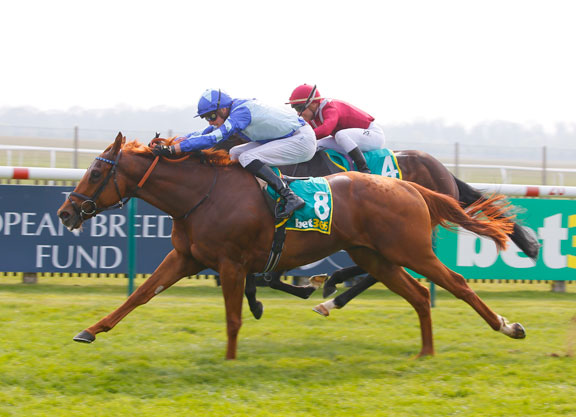By Andrew Caulfield
It was only a couple of weeks ago that I reminded everyone that marked success for a stallion is likely to breed more success four or five years down the line. On that basis, it looks to be a pretty safe bet that 2019 is going to be another big year for the 3-year-olds by Galileo (Ire), Shamardal, Dubawi (Ire), Dansili (GB), Invincible Spirit (Ire) and Oasis Dream (GB). The TDN's 2014 table of leading European sires by group winners records that all six of these stallions were represented by at least eight Northern Hemisphere group winners. All six then commanded fees of at least €70,000 in 2015.
Cheapest of the six, at €70,000, was Shamardal, even though he had ranked joint-second with Dubawi in 2014, with each of them being credited with a total of 14 group winners, including four Group 1 winners. While neither came close to matching Galileo's figures of 25 group winners and eight Group 1 winners, Shamardal deserved considerable credit–especially when many of his runners in 2014 had been sired at fees of around €20,000.
Nowadays it is tempting to think of Shamardal primarily as the sire of Lope de Vega, whose fee has risen as high as €80,000, but Shamardal is still no older than 17 and there are already strong indications that his 2016 crop is going to prove memorable.
Although it isn't one of his largest, it still numbers 108 foals and it has produced three individual group winners in recent weeks. Shaman (Ire) initiated the treble with his success in the G3 Prix La Force, which may have earned this four-time winner a tilt at the G1 Poule d'Essai des Poulains. Next came Castle Lady (Ire)'s victory in the G3 Prix de la Grotte, one of the main trials for the G1 Poule d'Essai des Pouliches. The treble was completed last week when the unbeaten Skardu (GB) narrowly landed the G3 Craven S. on only his second start to put himself into the G1 2000 Guineas picture.
This crop also includes the smart Emaraaty Ana (GB), winner last year of the G2 Gimcrack S. Watch out too for Tarnawa (Ire), an encouraging Leopardstown winner for the Aga Khan and the progressive Solid Stone (Ire), who gamely won a handicap at Newmarket.
One unusual aspect of Skardu's pedigree is that his fourth dam, the Seeking The Gold mare Spain Lane, was born comparatively recently, in 1991. Skardu is the second foal of a second foal who was the first foal of Quecha (Ire), the second foal of Spain Lane.
Although bred in the U.S., Spain Lane went into training with Andre Fabre and carried the Sheikh Mohammed colours with distinction. An impressive debut winner at Chantilly in June of her juvenile career, Spain Lane went on to be a good third to Coup de Genie in the G1 Prix Morny and runner-up to the champion filly Lemon Souffle (GB) in the G1 Moyglare Stud S.
Although her sire Seeking The Gold stayed a mile and a quarter, Spain Lane proved to be a sprinter like her grandsire Mr. Prospector. She gained her first group success in the G2 Prix du Gros-Chene over five furlongs and later added the G3 Prix de Seine-et-Oise over six. She rounded off her second season with a third behind the flying Lochsong (GB) in the Prix de l'Abbaye.
Spain Lane had the distinction of sharing her dam Regent's Walk with Marquetry, a top-class performer sired by another of Mr. Prospector's sons, Conquistador Cielo. A Grade I winner on dirt and turf, Marquetry won at up to a mile and a quarter, but his main achievement as a stallion was to sire Artax and Squirtle Squirt, both of whom earned the title of champion sprinter in the States.
Unfortunately, Spain Lane proved much less effective as a broodmare than as a racehorse. In a career which saw her visit the likes of Sadler's Wells, Darshaan (GB), Rainbow Quest, Storm Cat, El Prado (Ire), Green Desert and Pivotal (GB), she clearly didn't lack for opportunity but she had a moderate breeding record. Her final figures were just six foals, five starters and only two winners. Skardu's third dam, the Indian Ridge (Ire) mare Quecha, was second in fairly useful company on her only start at two in France but was then off the course for 10 months and ran poorly on her return. Timeform described her as headstrong.
Again, Quecha didn't want for opportunity early in her broodmare career, as her first three mates were Danehill, Anabaa and Sadler's Wells, and it was Exceed And Excel (Aus) who sired her best winner, the group-placed German two-year-old Lukrezia. Her Danehill filly Quaich (GB)–now the second dam of Skardu–won a seven-furlong maiden at Thirsk on her debut for Saeed bin Suroor.
Diala (Ire), the dam of Skardu, looked potentially useful when she won a Newmarket maiden over seven furlongs on her second start at two. Although she failed to make the expected progress, she ran respectably at three. This daughter of Iffraaj (GB) (Zafonic) began her broodmare career in Bahrain before being repatriated.
It is interesting that Shamardal sired Skardu from a mare from the Gone West sire line, as one of his other recent group winners, Castle Lady, is out of a grand-daughter of Gone West. Shamardal also sired the group-placed 2-year-old winner Desert Blossom (Ire) from a Zafonic mare and the Grade III winner Oregon Lady (Ire) from a Gone West mare, while Zafonic's son Xaar (GB) sired the second dam of Shamardal's son Hazapour (Ire), winner of the G3 Derrinstown Stud Derby Trial last year.
Although Shamardal stayed well enough to add the G1 Prix du Jockey Club to his victory in the Poule d'Essai des Poulains, the chances are that Skardu–with daughters of Iffraaj, Danehill and Indian Ridge as his first three dams–will prove best at around a mile.
Not a subscriber? Click here to sign up for the daily PDF or alerts.






